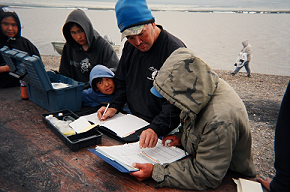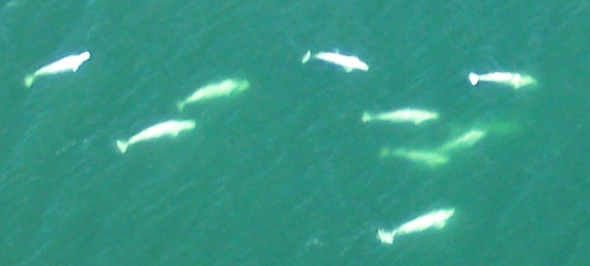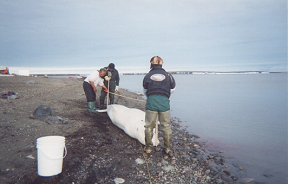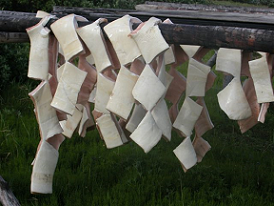Growth
Beluga whales landed in the subsistence harvest in the Estuary have been sampled and measured by the whale hunters, co-ordinating with field biologists, for over 30 years. Length and sex have been recorded since 1980; teeth have been taken for age determination since 1988. Almost all of the sampling has been done during July.

Length and sex have been recorded from 90 to 110 belugas per year. A total of 1064 animals were aged using growth layer groups (GLG) for 1988-2008. Landed males had a median length of 420cm and GLG counts from 8 to 67. Landed females had a median length of 368cm and GLG counts from 10 to 63. Hunters in the Mackenzie Estuary choose larger and older (>10 yr) animals which tend to be males. The sex ratio was approximately 2 males to each female for harvests between 1980 and 1989, three males to each female for harvests between the years 1990 and 1999, and almost four males to each female for harvests between the years 2000 and 2009. No reproductive females, particularly those with calves, are knowingly taken.

Sampling conducted in spring, as the Beaufort Sea beluga migrate from their Bering Sea wintering areas through the Chukchi and Beaufort seas, revealed that the beluga fed mainly (85%) on Arctic cod. There has been a weak but sustained trend of declining growth rates, starting about 2000 until 2008. This observation points to the possibility that changes occurring in the marine ecosystem may be influencing the beluga's prey base. Ringed seals have also exhibited a sustained decline in condition. Ringed seals also prey mainly on Arctic cod. Further research, including isotope and fatty acid profiling, would be helpful in substantiating the decling growth trend and may help indicate the factors contributing to it.
The corresponding changes in both beluga and ringed seal may indicate that climatic or oceanographic changes are occurring that are affecting species lower in the trophic pyramid. If that is the case, there could be profound ecosystem impacts.

Papers
L.A. Harwood, T.G. Smith, J.C. George, S.J. Sandstrom, W. Walkusz, & G.J. Divoky. 2015. Change in the Beaufort Sea ecosystem: Diverging trends in body condition and/or production in five marine vertebrate species. Prog. Oceanog. 136(2015):263-273. Click here
L.A. Harwood, M.C.S. Kingsley, & T.G. Smith. 2014. An emerging pattern of declining growth rates in belugas of the Beaufort Sea: 1989-2008. Arcitc 67(4): 483-492. Click here



